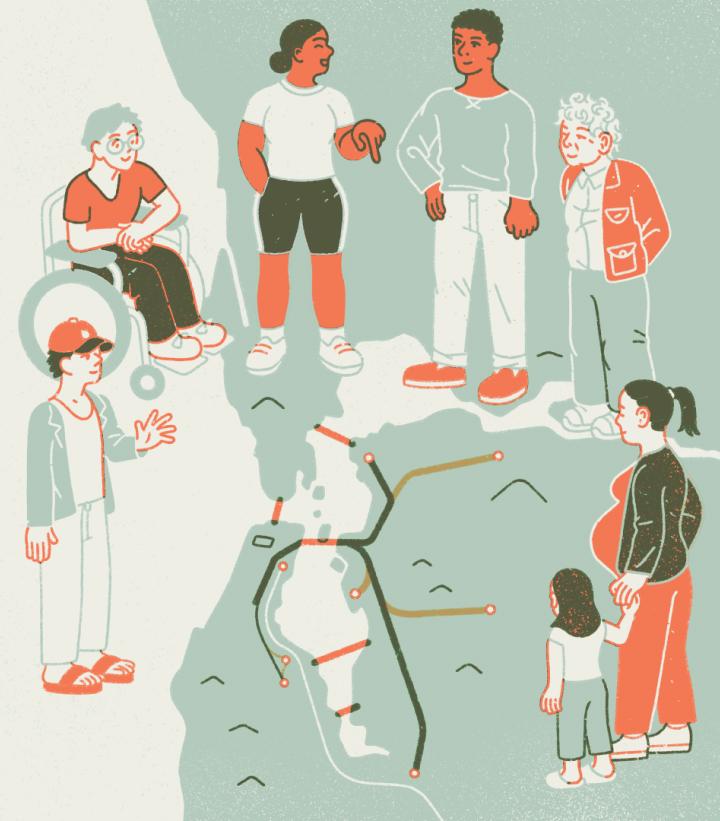Welcome to the future. We can’t get here without you.
Welcome to the future. We can’t get here without you.
It will take all of us to realize a truly inclusive vision of the Bay Area. Whether you’re a policy maker or simply someone who cares deeply about this shared place we call home, we hope you will join us in envisioning a better future for the region. Above, you can click into our Invitations to learn more, or dive straight into our Regional Strategy Reports Library.
The natural environment offers more than beauty.
The natural environment offers more than beauty.
Protecting our open spaces and agricultural lands…
Purifies our water
Provides natural habitat and stores carbon
Makes our communities more compact and easier to get around on foot or by bike
Encourages more efficient use of our streets, highways and transit systems
Creates new avenues for connection and opportunity
The price of a house can ignite something larger.
The price of a house can ignite something larger.
Affordable and sufficient housing…
Shortens car commutes, which…
Decreases the amount of carbon in the air, which…
Reduces global warming, which…
Prevents wildfires and other forms of ecological destruction that imperil California

Artwork: Leah Nichols for CMG Landscape Architecture Studio video
Everything is connected
Everything is connected
The task of tackling these crises can feel overwhelming, even impossible at times. But the fact is that stable housing, sustainable transportation, climate resilience and economic prosperity are not separate agendas — they are inextricably linked. We are one region, and working to solve one thing often connects to something larger and more impactful.
To see how we can work with nature to plan for sea level rise, read “San Francisco Bay Shoreline Adaptation Atlas.”
The challenges we seek to address are intertwined and far-reaching. But so are the solutions.
The challenges we seek to address are intertwined and far-reaching. But so are the solutions.
We believe in the seismic power of incremental shifts.
We believe in the seismic power of incremental shifts.
Changing the status quo won’t happen overnight, but the sooner we start, the farther we can go. If we correct course now, we can get the region on a healthier trajectory and create a more equitable and sustainable world for future generations.

Artwork: Nimah Gobir
From idea to action
From idea to action
This vision cannot remain an act of imagination. We can realize a Bay Area where:
- There is opportunity and belonging for all.
- Every family can achieve a stable and healthy standard of living.
- People come to create, invent and seek their fortunes.
- The region’s prosperity benefits everyone.
- Everyone can find a place to live and expect that their kids can stay here, too.
- We create great urban places while protecting the natural world.
- The impacts of one sector on another — housing, economy, environment, transportation — are intentional and positive.
To learn more about this vision, read “A New Civic Vision.”
Protect our region and all its inhabitants from climate change.
Protect our region and all its inhabitants from climate change.
Close the racial wealth and well-being gap.
Close the racial wealth and well-being gap.
Grow up, not out.
Grow up, not out.
Reimagine our housing policies.
Reimagine our housing policies.
What does the Bay Area look like in 2070? We invite you to imagine a place where we...
What does the Bay Area look like in 2070? We invite you to imagine a place where we...
We must right the wrongs.
We must right the wrongs.
Systemic racism has shaped the Bay Area and is a profound barrier to achieving our vision. Let’s make undoing it part of our future.
We are one region.
We are one region.
People don’t operate on a neighborhood scale alone — we live in the full context of a region.
Growth can be good.
Growth can be good.
With the right policies, we can provide enough housing for everyone who needs it, while keeping existing residents in their homes.
We do better together.
We do better together.
Community well-being is individual well-being — and vice versa. We all benefit when everyone’s basic needs are met.
There can be enough.
There can be enough.
In a region as innovative, creative and prosperous as ours, there actually is enough for everyone to thrive if we share resources more equitably.
So, let’s shift our perspective to clearly see what’s possible.
So, let’s shift our perspective to clearly see what’s possible.
So, let’s shift our perspective to clearly see what’s possible.
So, let’s shift our perspective to clearly see what’s possible.
It’s time for a bold new vision, led by purpose, backed by policy.
It’s time for a bold new vision, led by purpose, backed by policy.
We know radically positive things happen when people have what they need to thrive. Let’s set our collective sights on a future worthy of the region we love — a place of beauty, belonging, opportunity and innovation.

Artwork: Sophia Foster-Dimino
A better future for all
A better future for all
We now see that the region’s prosperity, equity and sustainability are interdependent — and so are we as individuals. The Bay Area can — and must — embrace a new civic vision that will guide us in creating a better future for everyone. Many times in the past, we’ve come together as one to make big collective changes — from environmental protection to marriage equality — and we can do it again.
To envision a future Bay Area with room and opportunity for everyone, read “A Civic Vision for Growth.”

Artwork: Innosanto Nagara
We can change course
We can change course
We know we have the experience, resources, self-awareness and imagination to address these problems. But as we’ve seen time and time again, nothing changes if nothing changes. The events of 2020 — the pandemic, wildfires and the Black Lives Matter movement — have put an urgent point on the disparity that’s been building here over decades. It’s clear that the way our communities have been designed over the last 50 years will not serve us for the next 50. To truly change course will call for a reexamination of beliefs, values and actions.
To understand the root of this problem, read “What It Will Really Take to Create an Affordable Bay Area.”
We are at a critical turning point.
We are at a critical turning point.
The Bay Area is a truly special place, but what got us here won’t get us where we want to go. In recent years, we’ve seen the region we love becoming harder and harder to afford. People who grew up here find they can’t stay. And those who once came here for opportunity now go elsewhere. That’s where we are. But it doesn’t have to be where we're going.
Artwork: Robert Saywitz of Emotive Brand
The future starts right here, together.
The future starts right here, together.
The future of the Bay Area is not an abstract idea; it’s a place we must plan for and build, together, from the ground up. The SPUR Regional Strategy invites you to imagine what the region could look like in the year 2070. That is, if we act now. Scroll up to experience the story, click on trees and buildings to learn more, or use the navigation bar to jump directly into our Reports Library of policy research.